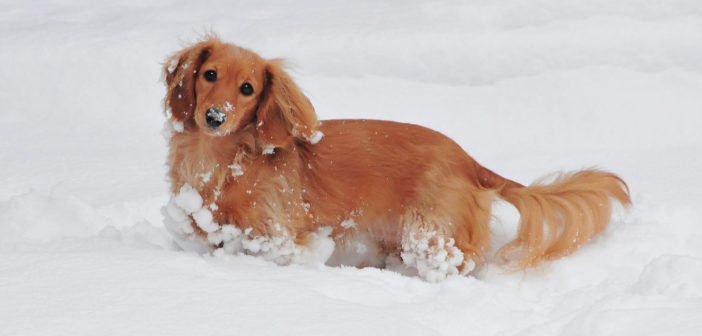As parts of the U.S. gear up for a powerful winter storm, packed with strong winds, heavy snow, and freezing rain, veterinarians at BluePearl Specialty and Emergency Pet Hospital are offering a few tips to help keep pets safe.
“Many people think that fur make dogs and cats more resistant to cold weather, but that is not necessarily true. Cold tolerance can vary based on a pet’s size, coat, body fat percentage, activity level, age and overall health,” remarked Harry Weatherson, ER Service Head and emergency veterinarian at BluePearl in New York City. “While huskies and other dogs bred for colder climates are more tolerant of cold weather, all dogs and cats are susceptible to frostbite and hypothermia. As a general rule, if it’s too cold for you, it’s too cold for your pet.”
While prolonged exposure to cold air, rain, sleet and snow can cause paws to become chapped and irritate your pet’s skin, there are other common winter-related issues pet owners should look out for.
Protect your pet from weather-related health dangers by remembering these eight winter safety tips.
Be mindful of your pet’s tolerance to cold. Consider shortening walks, especially if your dog is sick, small, short-haired, very young or old. Pets who fall into these categories tend to feel cold faster, and seniors, who may be arthritic, are more prone to falls. Pets with diabetes, heart disease, kidney disease or hormonal imbalances are also more susceptible to developing issues from cold weather due to their inability to regulate body temperature as effectively. If you are unsure of pet’s temperature limits, consult your veterinarian.
The best way to monitor your pet’s comfort level in the cold is to watch their behavior. If you notice that your pet is shivering/shaking/trembling, whining, acting lethargic or anxious, searching out warmth or shelter, or holding up one or more paws, that is a sign that it is time to head inside.
Check the paws. During a winter walk, salt, ice, antifreeze and coolants can irritate pets’ footpads and/or accumulate between toes. If chemicals from ice-melting agents are licked off paws, this can cause GI upset or a potentially more harmful effect. After walks, check your dog’s paws for signs of cold-weather injury or damage, such as cracked or bleeding paw pads. When possible, avoid salt and ice and immediately wash paws with warm water when you are back inside.
Keep an eye out for frostbite. Sensitive tissues like ears, noses and paw pads are susceptible to frostbite, so regularly check these areas for signs of cold weather related injuries or damage.

ID, leash, and chip. It is easy for pets to become lost in winter because snow masks familiar scents that can help them return home. Leash your pet during winter walks—especially during a snow storm—and make sure their ID tags are up-to-date. Consider microchipping to ensure a safe return home if your pet becomes lost.
Honk for sleeping animals. In cold conditions, animals (especially cats) like to seek shelter and warmth under or inside cars. Honk, open the car hood or loudly slap it to wake up any animal sleeping there. Lastly, visually check beneath the car to ensure that it is clear of all animals.
Never leave your pet in an unattended car. Car temperatures can drop quickly in colder months. Animals kept in cold cars can develop hypothermia or even freeze to death. Be sure to never leave your pet unattended in a vehicle and always keep the car at a comfortable temperature. Both extreme cold and extreme heat can negatively impact your pet’s health.
Consider adjusting diets. With walks cut short and less time spent outdoors in general, indoor pets can experience unhealthy weight gain. Ask your veterinarian for specific feeding recommendations and supplement the lost time outdoors with indoor playtime. Hide-and-seek with treats is one good way to keep your dog active indoors.
Be prepared. Like humans, your pet will need food and water if power goes out during a cold front or winter storm. Be sure to keep an ample supply of water, food, and medication (plan for five days), and store emergency numbers and addresses in a safe, easily accessible place. Keep copies of these emergency numbers in both your home and car for good measure.
Featured image: a dog plays in the snow. Be mindful of your dog’s tolerance for cold when it’s snowy outside. Image credit Mike McBey, CC BY-SA 2.0.





